With the recent boom of scleral lenses, practitioners are flooded with a range of lens designs to choose from. Although scleral lenses are the new hot trend, some patients might do better with alternative options such as piggybacking and hybrid contact lenses to improve vision and comfort and maintain long-term corneal health.
The piggyback system consists of a gas permeable (GP) lens fit on top of a soft contact lens. It offers the optics of a GP lens with the comfort of a soft contact lens. Hybrid lenses have a GP lens center surrounded by a soft contact lens skirt.1,2 They are similar to the piggyback system in that they, too, provide the optical quality of a GP lens with the comfort of a soft contact lens; but, unlike the piggyback system, they do so in one contact lens. Both of these options can be used as an alternative to conventional lenses. Here, we review the piggyback system and hybrid contact lenses and how they have progressed over the years.
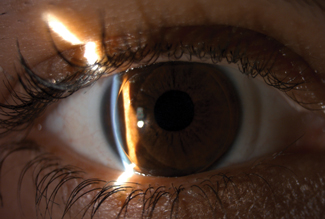 |
| Fig. 1. This patient is wearing a GP lens fit on top of a silicone hydrogel lens due to daily RGP lens awareness. |
Piggyback
The term piggyback was initially used to describe a GP lens fit on top of another GP lens for a bifocal effect.3 Today, it describes the doubling of a soft contact lens with a GP lens.
Before the invention of silicone hydrogel soft contact lenses, the low-Dk value of regular hydrogel soft contact lenses was insufficient for tear exchange around both soft and GP contact lenses, and users often developed corneal edema or neovascularization secondary to hypoxia.4,5 Today, providers can prescribe a silicone hydrogel lens under a GP and know the combination will not compromise the health of the cornea.3,4
Indications. Practitioners commonly consider piggybacking in current GP wearers with regular or irregular corneas who may need to be switched out of their GP lenses due to discomfort or corneal compromise.
While GP lenses are generally a comfortable option, a number of factors may contribute to lens discomfort, including: edge awareness, lens decentration or apical bearing. GP wearers can experience low tolerance to the lens and may complain of an upper or lower lid foreign body sensation. Due to a poor fit, GP lenses can rub against the cornea, causing pain and foreign body sensation, and possibly lead to central and peripheral superficial punctate keratitis—and even apical scarring. Long-term contact lens wearers with corneal ectasia may also experience corneal flattening with GP lens use. Additionally, it can be challenging to center a GP lens for a patient with significant irregular astigmatism, leading to decreased vision and comfort.6 A piggyback system can alleviate many of these factors and help to protect the cornea from contact-lens related adverse events.
In irregular corneas–for example, keratoconus–significant damage can occur with too much apical bearing. Keratoconic patients with signs and symptoms of corneal compromise are ideal candidates for piggybacking or a design change.
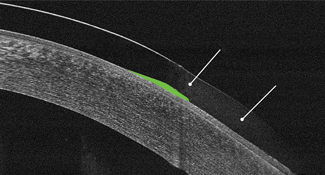 |
| Fig. 2. This OCT image highlights the company’s so-called “HyperBond” junction, designed to help reduce lens tearing. Photo: SynergEyes |
How it works. The soft contact lens shields the cornea from the GP lens, acting as a cushion between the GP lens and the cornea. In addition, the soft contact lens covers the entire cornea, minimizing the possibility of corneal abrasions or peripheral corneal abnormalities.7
The ideal soft contact lens in this system is a silicone hydrogel disposable lens. A daily disposable lens is often preferable to avoid having two lens cleaning systems. Silicone hydrogels are superior because they have higher Dk values than regular hydrogels and are more rigid, which allows them to drape around—rather than cling to—irregular corneas.
More than one fitting approach exists for a piggyback system, but some basic concepts are universal. When working with a current GP lens wearer who has discomfort, start with a low minus or plus silicone hydrogel lens below the GP lens. Some practitioners prefer to start with an insignificant amount of -0.5D or +0.5D power and then use the previous GP lens or fit a new GP as though the soft lens was not in place. In this case, practitioners often do not have to worry about a change in refractive power because the soft lens only accounts for about 20% of its power in the piggyback system.8 In a patient who does not always wear their soft lens, this is the best approach. If a stock lens results in stand-off, a custom soft lens with a steeper base curve may be necessary.9 In a new contact lens patient, keratometry measured over the soft contact lens can provide a starting point. Patients with a low apex may do well with a low to moderate plus lens.9 The GP lens should be well centered over the soft contact lens, with minimal edge lift and good movement upon blink.9,10,11
Pros: Patients do not need time to adjust to their lenses, and they have the optics necessary to see. The silicone hydrogel soft lens is in contact with the cornea and provides epithelial protection, which aids in maintaining the health of the cornea.8 Often, they can use their previous GPs comfortably. For irregular cornea patients, putting a soft contact lens underneath their current GP lens is a practical and safe option to keep them in their current lens modality.
Cons: The piggyback system requires insertion, removal and care for two different sets of contact lenses—which means twice as much money and time. In addition, patients should use a multipurpose solution approved for both soft and GP lenses. However, a daily disposable soft contact lens can mitigate some of these issues.4,12,10 For patients with a more progressed inferior cone, silicone hydrogels tend to wrinkle, making a successful fit difficult.
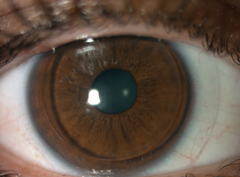 |
| Fig. 3. This patient was fit with a Duette hybrid lens with a silicone hydrogel skirt. |
Hybrids
The first hybrid contact lens, debuted in 1985, was made of crosslinking materials that locked together the GP center and soft skirt. The polymer materials, however, often failed and left users with ripped lenses. Moreover, the lens frequently had poor edge lift and inadequate movement, creating the potential for corneal neovascularization.13
In 2005, SynergEyes manufactured a new generation of hybrid contact lenses with new technologies aimed at reducing lens tears and increasing oxygen permeability (Figure 2). The new launch included lenses tailored to astigmatic (SynergEyes A), presbyopic (SynergEyes multifocal), keratoconic (SynergEyes KC) and postoperative (SynergEyes PS) patients.1,13
Soon after, the company came out with a second generation of hybrid contact lenses with GP lenses covalently bonded to soft skirts made of silicone hydrogel (Figure 3). The new unveiling included Duette, Duette multifocal, UltraHealth and UltraHealth FC with central and peripheral Dk values of 130 and 84, respectively (Figure 4).13,14 These new lenses provide a lower wetting angle and ultraviolet blocking, according to the company.15
Indications. These hybrid lenses do not correct for lenticular astigmatism and should only be considered for patients with little to no residual astigmatism. For most other cases, they work well on regular and irregular corneas, on patients with and without a history of GP lens use, and are generally good alternative to scleral contact lenses (Figure 4).13
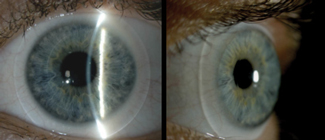 |
| Fig. 4. This patient with ocular surface disease achieved clear and comfortable vision with a hybrid lens. Photo: Alan M. Berman, OD |
How it works. Here is a quick look at each of the SynergEyes hybrid contact lenses:16
Duette (astigmatism and spherical). This lens is an option for highly myopic patients, soft toric lens wearers and GP intolerant patients. It offers stable, comfortable vision with its improved tear exchange and lens movement, according to the company. With the aspheric GP at 8.4mm in diameter and the silicone hydrogel skirt, the entire lens diameter is 14.5mm. These lenses are also available with Hydra-PEG polymer coating (Tangible Science) to improve contact lens comfort and wettability (Figure 5).16 These lenses are fit empirically with Ks and Rx, so practitioners do not need to use a diagnostic set.
Duette multifocal. This lens has a silicone hydrogel skirt, corrects for astigmatism and provides simultaneous vision. The center zone is aspheric and provides progression of power from near to distance. Practitioners can choose from three add powers (+1.00, +1.75 and +2.50D) and can choose to include the Hydra-PEG polymer coating. These lenses are also fit empirically with Ks and Rx without the need for a diagnostic set.16
UltraHealth. This second generation lens was designed to vault corneal ectasia and is indicated for patients with keratoconus, ectasias, post-surgery, post-corneal collagen crosslinking, Intacs corneal implant (AJL Ophthalmic) and other corneal irregularities. It has an aspheric reverse geometry GP center of 8.5mm and a total diameter of 14.5mm with the silicone hydrogel skirt and is also available with the Hydra-PEG polymer coating. Practitioners can use a diagnostic fitting set for these lenses.16
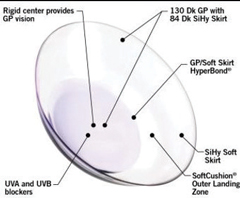 |
| Fig. 5. The Duette hybrid lens provides a GP lens center surrounded by a soft contact lens skirt. Photo: SynergEyes |
UltraHealth FC. An extension of UltraHealth, these lenses are indicated for post-corneal surgery or trauma and work well for oblate corneas. They include flatter base curves than the standard UltraHealth, have a silicone hydrogel skirt and are available with the Hydra-PEG polymer coating. A diagnostic fitting set is necessary when fitting patients.16
SynergEyes A. This hybrid lens—the first with FDA clearance—has a hema skirt and is indicated for patients with high astigmatism and early stages of keratoconus.16
SynergEyes KC. This option, also with a hema skirt, is designed for more advanced cases of keratoconus (Figure 6).16
SynergEyes ClearKone. This lens, with a hema skirt, is designed to vault over an irregular cornea to avoid compromising the ocular surface. The ClearKone lens has the ability to center independent of the location of the cone, according to the company. It can be used for irregular corneas, as well as post-RK, PRK and LASIK patients.16
You can fit these lenses empirically or with diagnostic lenses. Empirical fittings require data on keratometry, horizontal visible iris diameter and refraction. The fit should focus on good centration and coverage with movement of one millimeter upon blink in forward gaze. The most important aspect is making sure there is adequate tear exchange to prevent tight lens syndrome. Flattening the skirt curvature can address inadequate movement. The GP base curve is calculated from flat K measurements.
Patients should be educated that they might experience initial, though temporary, discomfort while adapting to a low modulus lens. UltraHealth, UltraHealth FC and ClearKone allow providers to select vault size, and Duette multifocal comes in three different add powers.
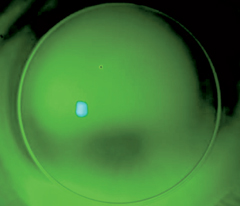 |
| Fig. 6. The right SynergEyes KC lens on this patient demonstrates “feather” touch with intermediate tear pooling. Photo: Robert L. Gordon, OD, and Sharon S. Hiyama, OD |
Pros: Hybrid contact lenses offer patients clear, comfortable vision while maintaining corneal health. They are good for patients with and without a history of GP lens use and for patients with irregular corneas. They have six-month replacement schedules, and patients must order them through your office because they are not available online or through discount retailers. Thus, they are especially beneficial for practitioners interested in patient retention and practice building.2,14
Hybrid contact lenses are easier to care for than piggyback systems because only one cleaning solution, usually a hydrogen peroxide solution, is required. Patients should also be educated on using a daily cleaner approved for both soft and GP lenses.
Cons: Patients may have difficulty with lens insertion and removal because many only have a history of soft contact lens use and are not yet comfortable removing a low modulus lens. Practitioners must set aside extra time to instruct these patients. Older generation hybrid lenses (SynergEyes A, KC and ClearKone) have hema skirts, which is a hydrogel monomer and has a low oxygen permeability.9 In relation to the piggyback system, hybrid lenses will be more expensive. To help address any complications, SynergyEyes has a patient hotline available 24/7 to answer any questions, as well as an online resource to help practitioners select the initial lens.13
Piggyback systems and hybrid contact lenses can offer many patients clear, comfortable vision with few disadvantages. Practitioners should consider these modalities for a variety of patients, especially now that the technology behind them has improved significantly. Knowing when to implement both of these lenses will differentiate you and add to your specialty lens practice.
Dr. Sherman is an instructor in Optometric Science (in Ophthalmology) at Columbia University Medical Center. She received her undergraduate degree from the University of Michigan and graduated from SUNY College of Optometry. She completed her optometric residency in Ocular Disease and Primary Care at Bronx Lebanon Hospital Center. She specializes in complex and medically necessary contact lens fittings and ocular disease.
Mr. Wilson is a graduate of Yale University and a third year OD/MS candidate at SUNY College of Optometry. He is interested in specialty contact lenses and the management of corneal disease.
1. Potter R. The history of hybrid contact lenses. Contact Lens Spectrum. 2015. www.clspectrum.com/issues/2015/november-2015/the-history-of-hybrid-contact-lenses. Accessed June 10, 2017.
2. Woo SL. Say hi to hybrids! Review of Cornea and Contact Lenses. September 2014:30-1.
3. Baldone JA. The fitting of hard contact lenses onto soft contact lenses in certain diseased conditions. Contact Lens Med Bull. 1973;6:15-7.
4. Michaud L, Brazeau D, Corbeil M-E, et al. Contribution of soft lenses of various powers to the optics of a piggy-back system on regular corneas. Cont Lens Anterior Eye. 2013;36(6):318-23.
5. López-Alemany A, González-Méijome JM, Almeida JB, et al. Oxygen transmissibility of piggyback systems with conventional soft and silicone hydrogel contact lenses. Cornea. 2006;25(2):214-9.
6. Nichols JJ, Willcox MDP, Bron AJ, et al. The TFOS International Workshop on Contact Lens Discomfort: Executive summary. Invest Ophthalmol Vis Sci. 2013;54(11):TFOS7-TFOS13.
7. The Vision Care Institute of Johnson and Johnson Medical Ltd. Soft contact lens fitting: essential contact lens practice. www.thevisioncareinstitute.ae/library. Accessed July 30, 2017.
8. Gas Permeable Lens Institute. Contact lens clinical pearls pocket guide. www.gpli.info/fitting-guide/. Accessed July 31, 2017.
9. Bennett E, Henry V. Clinical Manual of Contact Lenses. 4th ed. Philadelphia: LWW; 2013.
10. Romero-Jiménez M, Santodomingo-Rubido J, Flores-Rodríguez P, et al. Which soft contact lens power is better for piggyback fitting in keratoconus? Cont Lens Anterior Eye. 2013;36(1):45-8.
11. Steele C. Contact lens fitting today: fitting the irregular cornea. October 21, 2015. www.davidthomas.com/assets/Uploads/pdfs/Contact_lens_fitting_today_for_the_irregular_cornea-Chris_Steele.pdf. Accessed June 15, 2017.
12. Chang CY, DeNaeyer GW. Specialty contact lenses: treat your keratoconus patients right. Review of Cornea and Contact Lenses. March/April 2017:14-7.
13. Sicks LA. Hybrid lens basics. American Optometric Association. 2016. www.aoa.org/Documents/Hybrid Lens Basics Article.pdf. Accessed June 10, 2017.
14. Tyler’s Quarterly Soft Contact Lens Parameter Guide. 2016;34(1):60.
15. Sonsino J, Davis R. Keeping hybrids in focus. Contact Lens Spectrum. 2017. www.clspectrum.com/issues/2017/june-2017/keeping-hybrids-in-focus?eid=372303843&bid=1774827. Accessed June 16, 2017.
16. SynergEyes. http://synergeyes.com/professional/. Accessed July 26, 2017.


